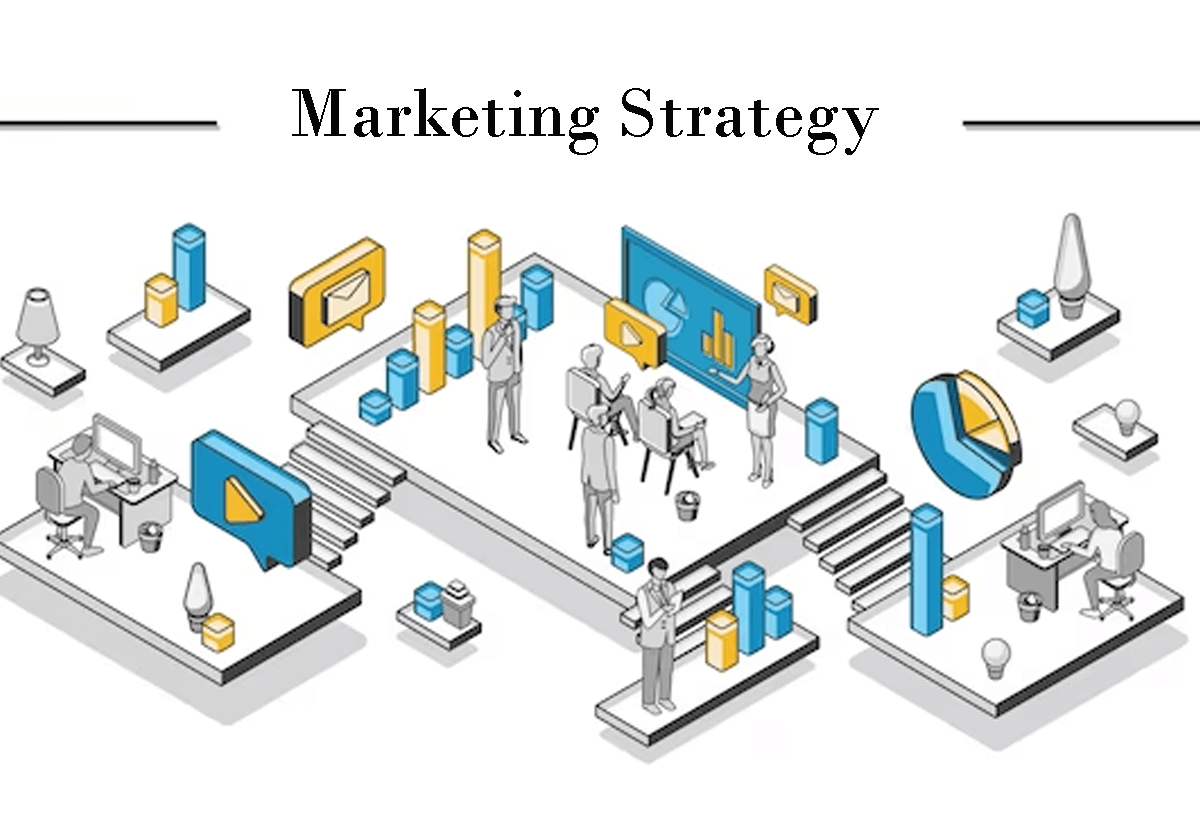What's Inside?
Marketing strategy refers to a company’s overall plan of action to reach its marketing goals and objectives. It involves making strategic decisions on how to effectively promote and sell products or services to target customers. A marketing strategy encompasses various elements, such as market research, target market identification, competitive analysis, positioning, pricing, distribution, and promotional activities. The goal of a marketing strategy is to create a competitive advantage, drive customer engagement, and ultimately achieve business growth and profitability.
Benefits of marketing strategy
A marketing strategy offers numerous benefits for businesses. Here are some key advantages:
- Clear Direction: A well-defined marketing strategy provides a clear direction and purpose for marketing efforts. It sets specific goals, identifies target markets, and outlines the steps to achieve them. This clarity helps align the marketing team and the entire organization, ensuring everyone is working towards a common objective.
- Market Focus: A marketing strategy enables businesses to focus their efforts on the most valuable and profitable market segments. By identifying target customers and understanding their needs, preferences, and behaviors, companies can tailor their marketing messages and offerings to effectively reach and engage their ideal audience.
- Competitive Advantage: A strong marketing strategy helps differentiate a business from its competitors. It identifies unique selling propositions and positions the company’s products or services in a way that highlights their distinct advantages. This differentiation enhances the company’s competitive advantage, making it more appealing to customers in the market.
- Resource Optimization: With a marketing strategy in place, businesses can allocate their resources more effectively. They can prioritize marketing initiatives and investments based on their strategic importance and expected return on investment. This ensures that resources, such as budget, time, and personnel, are allocated to the most impactful activities, maximizing their efficiency and effectiveness.
- Increased Customer Engagement: A well-executed marketing strategy helps build strong customer relationships and drives customer engagement. By understanding customer needs, preferences, and pain points, companies can develop targeted marketing campaigns that resonate with their target audience. This leads to increased customer interest, brand loyalty, and higher levels of customer satisfaction.
- Improved Decision Making: A marketing strategy provides a framework for data-driven decision making. By monitoring and analyzing key performance indicators (KPIs) and market trends, businesses can make informed decisions regarding pricing, product development, promotional activities, and distribution channels. This helps minimize risks and optimize marketing efforts for better results.
- Brand Building: An effective marketing strategy plays a crucial role in brand building. It helps create brand awareness, shape brand perceptions, and establish a positive brand image in the market. Through consistent messaging, positioning, and storytelling, businesses can develop a strong brand identity that resonates with customers and sets them apart from competitors.
- Long-term Growth: A marketing strategy focuses not only on short-term goals but also on long-term growth and sustainability. By implementing strategic marketing initiatives, businesses can build a strong customer base, expand market share, and generate consistent revenue streams. This long-term focus ensures the business remains competitive and profitable in the market.
A well-crafted marketing strategy provides a roadmap for success, guides decision making, and enables businesses to effectively reach and engage their target customers. It is an essential tool for achieving business growth, increasing market share, and building a strong brand presence.
What is included in a marketing strategy?
 A comprehensive marketing strategy typically includes the following components:
A comprehensive marketing strategy typically includes the following components:
- Market Research: This involves gathering and analyzing data about the target market, including customer demographics, needs and preferences, buying behavior, market trends, and competitive landscape. Market research helps businesses understand their customers and the market dynamics they operate in.
- Target Market Identification: Defining the specific segments or groups of customers that the business intends to target. This involves identifying the characteristics, behaviors, and needs of the ideal customers to tailor marketing efforts effectively.
- Unique Selling Proposition (USP): Determining the unique qualities, features, or benefits that set the company’s products or services apart from competitors. The USP defines what makes the business unique and why customers should choose its offerings over alternatives.
- Positioning: Developing a positioning strategy that determines how the company wants its brand and offerings to be perceived in the minds of customers. This involves identifying key messages, value propositions, and the overall brand image that align with the target market’s desires and expectations.
- Marketing Objectives: Setting specific and measurable goals that align with the overall business objectives. Marketing objectives can include increasing brand awareness, generating leads, boosting sales revenue, improving customer retention, expanding market share, or launching new products.
- Marketing Mix: Developing strategies for the various elements of the marketing mix, also known as the “4Ps”:
- Product: Defining the features, attributes, and benefits of the product or service to meet customer needs and preferences.
- Price: Determining the pricing strategy that aligns with the target market’s perceived value, competitive pricing, and profitability objectives.
- Place (Distribution): Deciding on the channels and methods to distribute and deliver the product or service to customers effectively.
- Promotion: Planning the promotional activities and tactics to create awareness, generate interest, and persuade customers to take action. This includes advertising, public relations, sales promotions, digital marketing, and other communication channels.
- Marketing Budget: Allocating financial resources for marketing activities. This involves determining the overall marketing budget, as well as budget allocation across different marketing initiatives, campaigns, and channels.
- Implementation Plan: Outlining the specific actions, timelines, and responsibilities for executing the marketing strategy. This includes creating a detailed plan for implementing marketing campaigns, monitoring progress, and adapting strategies as needed.
- Measurement and Evaluation: Defining key performance indicators (KPIs) and metrics to measure the effectiveness and success of the marketing strategy. This includes tracking and analyzing data on sales, customer acquisition, customer retention, brand awareness, website traffic, social media engagement, and other relevant metrics.
- Review and Adaptation: Regularly reviewing the performance of the marketing strategy, analyzing data, and making adjustments based on market changes, customer feedback, and emerging trends. A marketing strategy should be flexible and adaptable to ensure its ongoing relevance and effectiveness.
Each business’s marketing strategy will be unique, tailored to its specific industry, target market, and objectives. The components listed above provide a general framework for developing a comprehensive marketing strategy.
Why is having a marketing strategy important?
Having a marketing strategy is important for several reasons:
- Clear Direction: A marketing strategy provides a clear direction and purpose for marketing efforts. It outlines specific goals, target markets, and the steps to achieve them. This clarity helps align the marketing team and the entire organization, ensuring everyone is working towards a common objective.
- Focus on Target Markets: A marketing strategy helps businesses focus their efforts on the most valuable and profitable market segments. By identifying target customers and understanding their needs, preferences, and behaviors, companies can tailor their marketing messages and offerings to effectively reach and engage their ideal audience.
- Competitive Advantage: A well-defined marketing strategy helps differentiate a business from its competitors. It identifies unique selling propositions and positions the company’s products or services in a way that highlights their distinct advantages. This differentiation enhances the company’s competitive advantage, making it more appealing to customers in the market.
- Efficient Resource Allocation: With a marketing strategy in place, businesses can allocate their resources more effectively. They can prioritize marketing initiatives and investments based on their strategic importance and expected return on investment. This ensures that resources, such as budget, time, and personnel, are allocated to the most impactful activities, maximizing their efficiency and effectiveness.
- Consistent Branding and Messaging: A marketing strategy ensures consistent branding and messaging across all marketing channels and touchpoints. It establishes guidelines for the company’s visual identity, tone of voice, and communication style. Consistent branding helps build brand recognition, credibility, and trust among target customers.
- Adaptation to Market Changes: A marketing strategy allows businesses to adapt to market changes and evolving customer preferences. By regularly reviewing and evaluating the strategy, businesses can identify shifts in the market, emerging trends, or new opportunities. This flexibility enables them to make timely adjustments to their marketing tactics and stay relevant in a dynamic business environment.
- Measurable Results: A marketing strategy sets specific goals and defines key performance indicators (KPIs) to measure the success of marketing efforts. It enables businesses to track and analyze the effectiveness of their marketing activities, identify areas for improvement, and optimize their strategies for better results. Measurable results provide insights into the return on marketing investment and help make data-driven decisions.
- Long-Term Growth: A marketing strategy focuses not only on short-term goals but also on long-term growth and sustainability. By implementing strategic marketing initiatives, businesses can build a strong customer base, expand market share, and generate consistent revenue streams. This long-term focus ensures the business remains competitive and profitable in the market.
A well-crafted marketing strategy provides a roadmap for success, guides decision-making, and enables businesses to effectively reach and engage their target customers. It is an essential tool for achieving business growth, increasing market share, and building a strong brand presence.
How to create a successful marketing strategy
Creating a successful marketing strategy involves several key steps. Here’s a general framework to guide you through the process:
- Set Clear Objectives: Start by defining your marketing objectives. What do you want to achieve with your marketing efforts? Examples could include increasing brand awareness, driving sales revenue, expanding into new markets, or launching a new product. Ensure your objectives are specific, measurable, achievable, relevant, and time-bound (SMART).
- Understand Your Target Market: Conduct thorough market research to understand your target customers. Identify their demographics, needs, preferences, behaviors, and pain points. This information will help you tailor your marketing messages and strategies to resonate with your audience.
- Define Your Unique Selling Proposition (USP): Determine what sets your products or services apart from the competition. Identify the unique qualities, features, or benefits that make your offering valuable to customers. Your USP should address a specific customer need or provide a solution that is different from what competitors offer.
- Conduct a Competitive Analysis: Evaluate your competitors to understand their positioning, messaging, and marketing strategies. Identify their strengths, weaknesses, and areas where you can differentiate yourself. This analysis will help you identify opportunities and threats in the market.
- Determine Your Marketing Mix: Develop strategies for each element of the marketing mix:
- Product: Define the features, attributes, and benefits of your product or service. Determine how it meets customer needs and differentiates itself in the market.
- Price: Set pricing strategies that align with your target market’s perceived value, competitor pricing, and your business goals.
- Place (Distribution): Determine the channels and methods through which you will distribute and deliver your product or service to customers.
- Promotion: Plan your promotional activities and tactics to reach and engage your target market. This includes advertising, public relations, digital marketing, content marketing, social media, and other relevant channels.
- Develop Your Marketing Budget: Allocate resources to support your marketing initiatives. Consider your marketing objectives, the scope of your activities, and the expected return on investment. Allocate your budget across different marketing channels and tactics based on their potential effectiveness and alignment with your target audience.
- Implement and Measure: Implement your marketing strategies and initiatives, while closely monitoring their performance. Track key performance indicators (KPIs) relevant to your objectives, such as sales revenue, website traffic, conversion rates, customer acquisition costs, and customer satisfaction. Regularly review and analyze the data to measure the effectiveness of your marketing efforts and make adjustments as needed.
- Stay Agile and Adapt: Markets and customer preferences change over time, so be prepared to adapt your marketing strategy. Stay informed about industry trends, monitor your competitors, and listen to customer feedback. Continuously evaluate and refine your marketing activities to optimize results and seize new opportunities.
- Review and Improve: Conduct periodic reviews of your marketing strategy to assess its effectiveness. Identify areas where you can improve and make adjustments based on market feedback and performance data. Keep testing and experimenting to find what works best for your target audience.
A successful marketing strategy is not static but evolves with your business and the market. Regularly revisit and update your strategy to ensure it remains relevant and aligned with your goals and customers’ needs.
What do the four Ps mean in a marketing strategy?
 The four Ps in marketing strategy refer to the four key elements that businesses consider when developing and implementing their marketing plans. They are:
The four Ps in marketing strategy refer to the four key elements that businesses consider when developing and implementing their marketing plans. They are:
- Product: This refers to the goods or services that a company offers to its customers. It involves decisions related to product features, design, quality, packaging, branding, and any additional value-added services. The goal is to create products that meet customer needs and provide value.
- Price: Price refers to the amount of money customers are willing to pay for a product or service. Pricing decisions involve setting the right price point that aligns with the perceived value of the product, considers production costs, takes into account competitor pricing, and supports the company’s financial goals. Pricing strategies can include penetration pricing, premium pricing, or price skimming, among others.
- Place (Distribution): Place refers to the channels and methods through which products or services are made available to customers. It involves decisions related to distribution channels, logistics, inventory management, and physical or online store locations. The goal is to ensure that products are conveniently accessible to the target market.
- Promotion: Promotion refers to the activities used to communicate and promote products or services to the target market. It includes advertising, public relations, sales promotions, direct marketing, social media marketing, content marketing, and other promotional tactics. The objective is to create awareness, generate interest, and persuade customers to choose the company’s products or services over competitors.
The four Ps framework provides a comprehensive approach to developing marketing strategies. By considering each element, businesses can effectively address product development, pricing, distribution, and promotional aspects to meet customer needs, differentiate themselves from competitors, and create value in the market.
Is a marketing strategy the same as a marketing plan?
No, a marketing strategy and a marketing plan are not the same, although they are closely related.
A marketing strategy is a high-level approach that outlines the overall goals and objectives of a business’s marketing efforts. It involves defining the target market, understanding customer needs, identifying competitive advantages, and establishing a general direction for achieving marketing objectives. A marketing strategy sets the foundation and guides the decision-making process for the marketing activities of a business.
On the other hand, a marketing plan is a detailed document that outlines the specific actions, tactics, and timelines to implement the marketing strategy. It translates the strategy into actionable steps and provides a roadmap for executing marketing campaigns and initiatives. A marketing plan typically includes a situational analysis, target market analysis, marketing objectives, marketing mix strategies, budget allocation, implementation timelines, and evaluation methods.
A marketing strategy provides the overarching direction and approach, while a marketing plan is the detailed roadmap that outlines how the strategy will be implemented. The strategy sets the goals and identifies the target market, positioning, and competitive advantage, while the plan lays out the specific actions, resources, and timelines to achieve those goals.
Marketing strategy vs. Marketing plan
Marketing strategy and marketing plan are two distinct but interconnected components of a company’s overall marketing efforts. Here’s a breakdown of the differences between the two:
Marketing Strategy:
- Marketing strategy is a long-term, high-level approach that outlines the company’s overall marketing goals and objectives.
- It involves defining the target market, understanding customer needs and preferences, identifying competitive advantages, and determining the positioning and value proposition of the company’s offerings.
- A marketing strategy provides a clear direction and framework for making marketing decisions and guiding the overall marketing efforts of the company.
- It sets the foundation for developing a marketing plan and ensures that all marketing activities are aligned with the company’s strategic objectives.
Marketing Plan:
- A marketing plan is a detailed document that operationalizes the marketing strategy into actionable steps and tactics.
- It outlines the specific marketing activities, campaigns, and initiatives that will be implemented within a defined timeframe, such as a year or a quarter.
- A marketing plan includes detailed information about target market segments, marketing objectives, marketing mix strategies (product, price, place, promotion), budget allocation, timelines, and performance measurement metrics.
- It provides a roadmap for executing marketing initiatives, coordinating resources, and monitoring the progress of marketing activities.
- A marketing plan is usually created for a specific period and is subject to revision and updates as market conditions and business objectives change.
A marketing strategy is a broader, long-term approach that sets the direction and goals of a company’s marketing efforts. A marketing plan, on the other hand, is a detailed document that outlines the specific tactics, activities, and timelines for implementing the marketing strategy. The strategy defines the “what” and “why,” while the plan focuses on the “how” and “when” of marketing execution.


